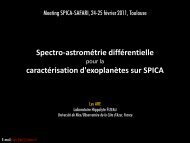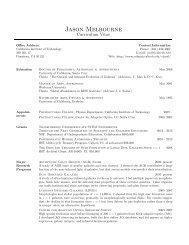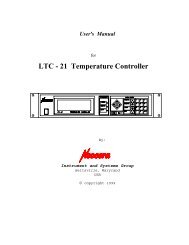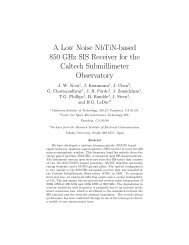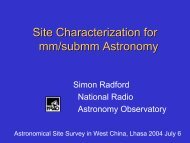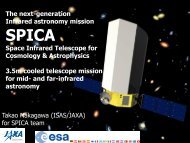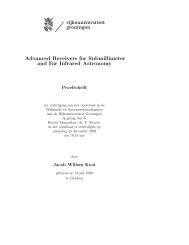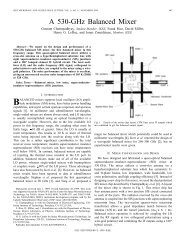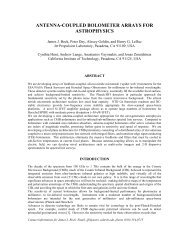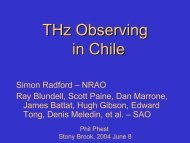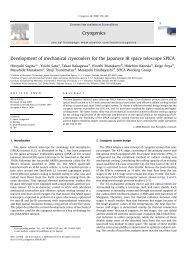Design of a side-band-separating heterodyne mixer for band 9 of ...
Design of a side-band-separating heterodyne mixer for band 9 of ...
Design of a side-band-separating heterodyne mixer for band 9 of ...
You also want an ePaper? Increase the reach of your titles
YUMPU automatically turns print PDFs into web optimized ePapers that Google loves.
S 1 1<br />
[d B ]<br />
-2 0<br />
-3 0<br />
-4 0<br />
-5 0<br />
(a )<br />
d W<br />
= c W<br />
= 1 5 0 0 µm & c 2 L<br />
= 5 0 0 µm<br />
a L<br />
= 1 5 5 & e d 1 L<br />
= 0<br />
a L<br />
= 2 1 7 & e d 1 L<br />
= 0<br />
a L<br />
= 3 1 0 & e d 1 L<br />
= 0<br />
a L<br />
= 3 1 0 & e d 1 L<br />
= -5<br />
a L<br />
= 3 1 0 & e d 1 L<br />
= 5<br />
REFERENCES<br />
[1] J. W. Kooi, A. Kovacs, B. Bumble, G. Chattopadhyay, M. L. Edgar,<br />
S. Kaye, R. LeDuc, J. Zmuidzinas, and T. G. Phillips, Heterodyne<br />
Instrumentation Upgrade at the Caltech Submillimeter Observatory.<br />
[2] G. A. Ediss, A. R. Kerr, H. Moseley, and K. P. Stewart, ”FTS Measurements<br />
<strong>of</strong> Eccosorb MF112 at Room Temperature and 5 K from 300<br />
GHz to 2.4 THz”, ALMA Memo 273, 2 September 1999.<br />
[3] http://www.eccosorb.com/.<br />
[4] F. P. Mena and A. Baryshev, ”<strong>Design</strong> and Simulation <strong>of</strong> a Waveguide<br />
Load <strong>for</strong> ALMA-<strong>band</strong> 9”, ALMA Memo 513, 5 January 2005.<br />
[5] http://www.sonnetusa.com/.<br />
[6] Private communication, Radiometer Physics GmbH,<br />
http://www.radiometer-physics.de.<br />
S 1 1<br />
[d B ]<br />
-2 0<br />
-3 0<br />
-4 0<br />
ε 0<br />
= 5 .1<br />
ε 0<br />
= 1 0<br />
ε 0<br />
= 3 0<br />
-5 0<br />
(b )<br />
5 5 0 6 0 0 6 5 0 7 0 0 7 5 0<br />
f [G H z ]<br />
Fig. 7. Simulation <strong>of</strong> the load per<strong>for</strong>mance when : (a) mounting errors<br />
(a L < a; e d1L ≠ 0) are present and (b) different materials are used.<br />
in both directions produce a rather large degradation <strong>of</strong> the<br />
per<strong>for</strong>mance <strong>of</strong> the load. However, errors as large as 20 µm<br />
produce still a reflectivity below -20 dB (not shown here).<br />
Finally, we have modeled the per<strong>for</strong>mance <strong>of</strong> the load with<br />
different materials. This have been simulated by changing<br />
the Lorentz model given in Table I. The specific parameter<br />
changed is the static value <strong>of</strong> the dielectric function (ɛ 0 ≡<br />
ɛ(0) = ɛ ∞ + ω2 p<br />
). Fig. 7b shows the results that demonstrate<br />
ω0<br />
2<br />
the ability <strong>of</strong> our design to per<strong>for</strong>m efficiently with a wide<br />
range <strong>of</strong> materials.<br />
IV. CONCLUSIONS<br />
In conclusion we have presented a design <strong>for</strong> a <strong>side</strong>-<strong>band</strong><strong>separating</strong><br />
<strong>mixer</strong> <strong>for</strong> the frequency region corresponding to<br />
ALMA <strong>band</strong> 9. Its ideal and non-ideal properties have been<br />
presented from which it is estimated that tolerances in some<br />
<strong>of</strong> the components should be as low as 3 µm. We think these<br />
tolerances are achievable with state-<strong>of</strong>-the-art micromachining,<br />
which is confirmed by the first promising attempts [6]. A<br />
design <strong>of</strong> a new load has also been presented. Its relatively<br />
large dimensions respect to the waveguide make it appropriate<br />
<strong>for</strong> high frequencies. Moreover, the results <strong>of</strong> the simulations<br />
indicate that the design is very robust as can tolerate rather<br />
large mounting errors and a wide variety <strong>of</strong> absorbing materials.



